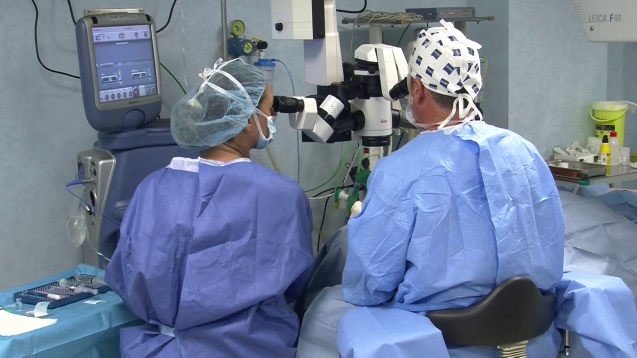Treatment of glaucoma
How do we treat glaucoma?
The aim of glaucoma treatment is to reduce the pressure within the eye to a level at which it no longer damages the eyesight. Three types of treatment are used: eye drops, laser, surgery, or combinations of these. The drops are of various compositions and makes, none of which suit all patients. The specialist must often try several until the internal eye pressure is controlled.
Importance of following the prescribed treatment
One concern in the treatment of glaucoma is that patients often fail to follow the treatment prescribed by the ophthalmologist. A study by the John Hopkins University in the U.S. showed that only 56 % of patients continued treatment after being diagnosed with glaucoma. While the causes of this lack of monitoring are varied and often psychological in origin, it is most important that patients understand that treatment dropout poses a serious danger to their vision. This we have unfortunately proven over the years at our Institute.
Surgery as treatment of glaucomaSurgical treatment, using laser or not, is offered to those patients where the progression of the disease has not been halted by using the prescribed eyedrops. After pre-operative evaluation at our institute, the prospective patient will have a more realistic idea of the possible steps. Risks of surgerIt is known that just as when you ride by car or take a medicine, any operation carries a risk of complications. However once surgery is necessary, the danger of losing one’s sight if the glaucoma is not operated on becomes far higher than the possible complications. |
We answer the most frequent questions people ask about glaucoma:
[wpspoiler name=”What is glaucoma?”]
Glaucoma is a group of diseases that damage the optic nerve, essential to carry vision to the brain so we can see. Seriously affecting the field of vision, if not treated they can lead to blindness. Without treatment the damage is progressive.
It starts with a loss of peripheral vision unnoticed by the patient and then progresses toward the centre until it finally closes and completely obscures vision.
Disease progression may halt itself, but the vision already
lost is not recovered. The damage is usually associated with high fluid pressure
inside the eye, although in some cases it occurs even at apparently normal pressures. There are different types of glaucoma but by far the most common is simple chronic glaucoma (also called
primary open-angle glaucoma). Annual monitoring is therefore important for everyone over 40 years Diabetics are at increased risk. Subsequently, computerised perimetry or campimetry is of great value in monitoring the disease once established. These are part of the equipment at the Amigó Institute and are employed
routinely for the diagnosis of suspected glaucoma or follow-up of confirmed cases.
Although all treatments have a certain degree of risk, it is much lower than the probability of vision loss if left without appropriate treatment. [/wpspoiler] [wpspoiler name=”Is there a cure for glaucoma?”] No. The lost vision cannot be recovered. However drug treatment and when necessary laser or surgery usually detain progression of impaired vision enough to conserve a useful level of vision.[/wpspoiler] [wpspoiler name=”What is the best way to prevent vision Early detection of disease, based on regular checks by an ophthalmologist. Everyone, even those without risk factors, should be examined every 2 years from 40 years of age onwards. At our Institute we perform a thorough examination to rule out glaucoma in every patient over 40 years that consults us. We recommend this test be repeated every two years on a regular basis indefinitely. |
Back to
|
Go to a
|
Go to Glaucoma
|

